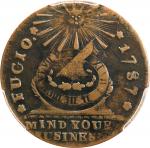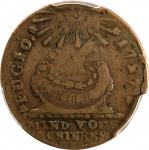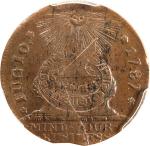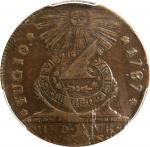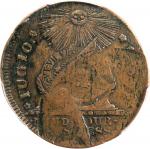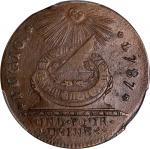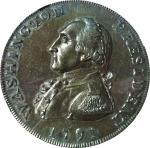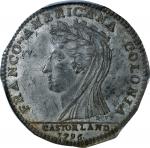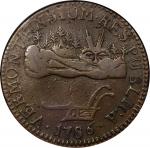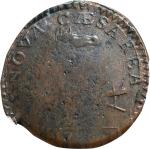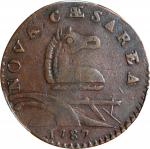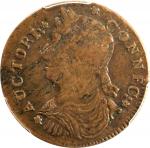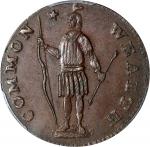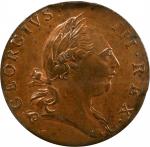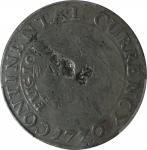1776 (1783) Continental Dollar. Newman 2-C, W-8445. Rarity-3. CURRENCY. Pewter. Good Details--Damage (PCGS). Examples of this iconic type are eagerly sought by numismatists at all levels of preservation. This is certainly a more affordable alternative, although the deep pewter surfaces do retain bold outline detail to most major design elements. The links along the upper reverse border are faint, yet still discernible, and only in the center of the obverse do we note considerable loss of detail. Digs and pits in the centers on both sides join with a lengthy scratch at the right obverse to explain the PCGS qualifier. If ever there was an example of this type that upheld the traditional story of commercial use in America during the Revolutionary War, this would be it. Based on modern scholarship (see below), however, this specimen is more likely a (very) poorly handled collector piece. The earliest known published record of the Continental "dollar" came, oddly enough, in the German book Historical and Genealogical Almanac, or Yearbook of the Most Remarkable New World Events for 1784 by Matthias Christian Sprengel. A few years later, in 1786, Bishop Richard Watsons Chemical Essays (Volume IV) also mentioned the Continental "dollar." Watson was a professor of chemistry and divinity at Cambridge sanctioned by the British Crown. Although the authors of these early publications obviously believed that the Continental "dollars" were coins of American manufacture, no documentary evidence was provided to substantiate this claim, a fact that has long troubled numismatic researchers. Recent research and a two-part article by Erik Goldstein and David McCarthy entitled "The Myth of the Continental Dollar" published in the January and July 2018 editions of The Numismatist challenge the long accepted theories surrounding these coins. They discovered that a long string of early Americans went on the record to mention that they had never seen or heard of such a thing as a Continental dollar coin. Paul Revere and Josiah Meigs both went on the record within a decade of the end of the American Revolution to correct Bishop Watsons report that the pewter "dollar" was an American coin. That the Continental dollar was intended as a medal and not a coin, and that it was struck in London in 1783 instead of an unknown American location in 1776, changes very little in the scheme of things. The Libertas Americana medal was coined in Paris but is consistently rated as among the most desirable American numismatic collectibles; the Continental "dollar" should not forfeit a similar place in the hearts of American collectors. It remains scarce, attractive, historic and valuable. Its a piece that Paul Revere -- no man of letters, typically -- felt passionately enough about to write a missive to the Bishop of London. And its a piece that all of us grew up looking at and wanting to own, just as every generation of American collector since 1823 has. Indeed, the inclusion of a Continental "dollar," even one such as this, will continue to help define the difference between an average and outstanding collection of early American types. PCGS# 794. NGC ID: 2AYT.

